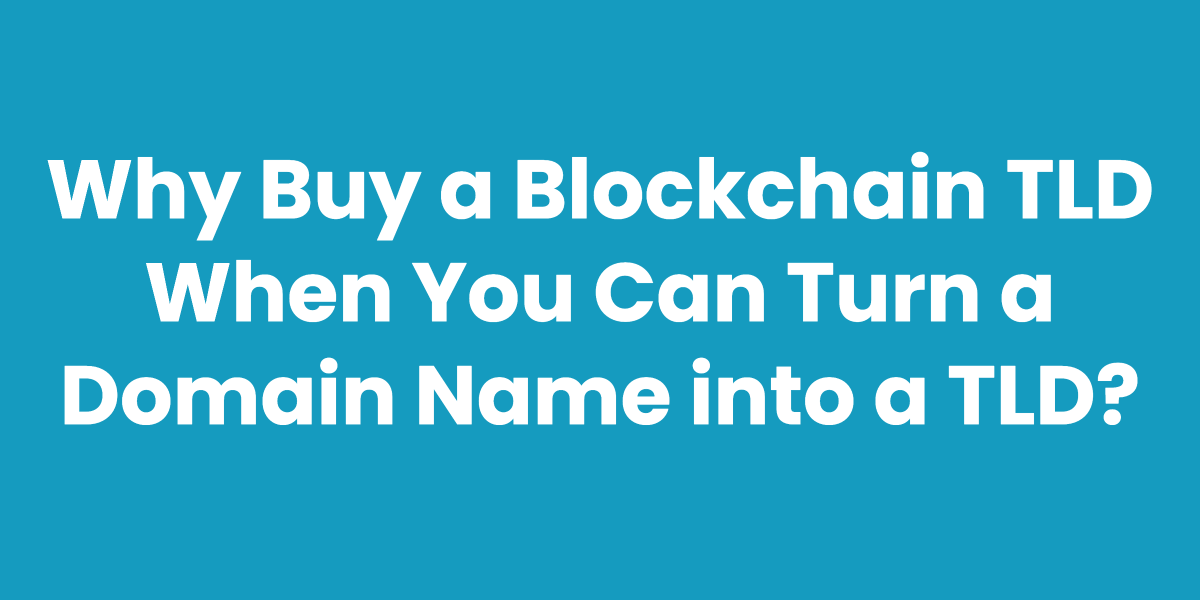Wouldn’t it be appealing to operate as a domain name registry, sell countless domain names, have a recurring revenue stream, and bypass the bureaucratic hurdles and high costs associated with ICANN?
Essentially, this means enjoying all the benefits without any drawbacks.
Millions of blockchain Top-Level Domains (TLDs) have been sold in auctions and the aftermarket, aiming to achieve this very goal.
Handshake (@HNS, handshake.org) and Freename (@Freenameio, freename.io) stand out as two of the largest providers of blockchain TLDs.
Additionally, numerous companies, such as Unstoppable Domains (@unstoppableweb, unstoppabledomains.com), are launching their own blockchains and are selling blockchain domains on their own blockchain TLDs.
However, a significant issue arises: blockchain domain names do not resolve in mainstream web browsers. This means that, for most people worldwide, blockchain domains seem non-functional unless they take extra steps like installing an extension, a resolver, or modifying zone records—actions that the average user is highly unlikely to do.
But there’s another option besides either an ICANN TLD or a blockchain TLD:
GoDaddy is exploring an alternative approach to capitalize on domain names: transforming a regular domain name into a top-level domain (TLD) in its own right.
Despite GoDaddy owning, managing, or operating over 240 TLDs—including .club, .design, .vip, .fashion, .yoga, and .cooking—with more than 14 million domain names under management across these TLDs, GoDaddy is now delving into the sale of third-level domains under the domain name graphic.design.
Yes, graphic.design.
Think:
- sanfrancisco.graphic.design (geo-domain)
- degree.graphic.design (3.6K USA search volume, $31.42 CPC)
- online.graphic.design (2.9K USA search volume, $8.62 CPC)
- jobs.graphic.design (33K USA search volume, $1.63 CPC)
Sales Potential and Revenue
GoDaddy believes that by offering third-level domain registrations on an attractive domain name such as graphic.design, they could sell between “5,000 to 10,000+” third-level domains, according to a recent article published by Kevin Murphy on Domain Incite (@DomainIncite, https://domainincite.com/29613-godaddy-to-start-selling-graphic-design-domains).
GoDaddy already owns the technology to manage the sale of domain names on a TLD, having acquired @Neustar‘s registry business in 2020 (https://www.home.neustar/about-us/news-room/press-releases/2020/neustar-sells-its-registry-business-to-godaddy), which allows it to operate TLDs on behalf of itself, sovereign nations, city governments, and global brands. So adding graphic.design has incremental costs.
Assuming between 5,000 and 15,000 domain registrations and given a realistic price range for new gTLDs typically falling between $20 and $50 each, the revenue from these graphic.design third-level domain name sales could amount to anywhere from $100,000 to $750,000 annually.
Moreover, premium registrations—high-value domains sold at elevated prices by the registry—could boost potential revenue by an additional 50% or more. In an optimal scenario, this strategy could generate over $1 million in revenue from third-level domain sales on a second-level domain like graphic.design.
This potential success hinges on GoDaddy’s tactics, discussed below. Because the selling of third-level domain names has been tried many times in the past.
Tried Many Times
GoDaddy is not the first company to attempt selling third-level domain names on a second-level domain.
This approach has previously been explored by numerous domain names, such as co.com, com.co, and cn.com (https://domainnamewire.com/2020/07/17/investing-in-cn-com-and-com-cn-names/).
The holy grail of owning a premium domain name is being able to sell an endless of supply of either email addresses or third-level domain names—in essence, acting like a domain name registry—but without the regulatory burden.
In 2015, I interviewed John Lyotier (@lyotier), then co-founder and CMO of Left of the Dot, on @DomainSherpa about implementing this strategy for domains like Villa.com, Oahu.com, and HomeStaging.com. During the interview, Lyotier shared that while the concept is appealing, it proves to be a challenging task that doesn’t always lead to a sustainable outcome.
A More Recent Example: IT.com
The purchase of IT.com for $3.5 million provides a recent example (https://domainnamewire.com/2021/11/01/company-that-paid-3-5-million-for-it-com-is-selling-subdomains/).
In 2021, the owners started selling subdomains, like example.it.com, to explore the revenue possibilities of third-level domain sales.
According to a recent post by Joe Alagna (@joealagna), sales director of IT.com, they appear to have sold more than 5,000 third-level domain names and expect to have sold 10,000 domain names by mid-2024.
Here’s a promotion from the @ICADomains event in February, so you get to know who’s behind this selling of these third-level domains:

Pros and Cons of the Third-Level Domain Name Sales Model
For investors interested in a recurring revenue stream, exploring the sale of third-level domain names presents an intriguing alternative to the traditional domain name market.
Pros:
- Cost-Effective: This approach can be significantly less expensive than acquiring a new TLD through ICANN, making it a more accessible option to more people.
- Lower Risk: The ICANN application and auction process involves considerable risk and unknowns. This can be mitigated by negotiating the purchase of a premium domain name suitable for offering third-level domains, as demonstrated by IT.com.
- Functionality: Companies purchasing domain names, whether third-level or second-level, require their websites to resolve in browsers and may need to receive emails from customers. Third-level domains work.
- Email Solutions: Pairing an email solution with third-level domain names is relatively straightforward. For example, if someone purchases whatever.it.com, they could offer email addresses like [email protected] through a DNS interface. Many companies, including Nike with [email protected], use third-level domain names for email, showcasing the viability of this approach.
Cons:
- Limited Recognition: Third-level domains are less recognized by the general public compared to second-level domains, potentially affecting the perceived legitimacy and memorability of a website.
- Dependence on the Second-Level Domain Owner: The stability and control of third-level domains depend entirely on the owner of the second-level domain. If the second-level domain is sold or the owner decides to change how they manage subdomains, third-level domain owners could lose their web presence (see links under “The Opportunity” below).
- SEO Challenges: It’s not clear how search engines like @Google will rank third-level domains. Nowadays, Google considers each subdomain as their own website, yet recognizes that they’re tied together in some way so they likely share SEO characteristics—for good and bad—potentially impacting visibility and traffic. But this may change over time, as Google has recognized that certain ccTLDs like .io or .ai are not distinctly associated with their respective countries and are now considered similar to “general” TLDs.
- Complexity for Users: Users might find third-level domains more complicated to remember and type, compared to more straightforward second-level domains.
- Limited Scalability: While selling third-level domains can be profitable, there’s a ceiling to how much you can scale, especially if the market perceives them as less desirable than second-level domains—which they are.
- Technical Limitations: Some web services and platforms may have limitations or do not fully support third-level domains, which could restrict the functionality available to end-users, like email systems that don’t accept [email protected] email addresses.
The Role of the Public Suffix List
And don’t be too quick to assume your domain name will function like an ICANN-approved TLD right out of the box.
A critical step in this strategy is getting your domain listed on the Public Suffix List (PSL), which is controlled by the Mozilla Foundation and maintained by volunteers.
You can find the Public Suffix List (PSL) at publicsuffix.org, where information on how to list your third-level domain name is available.
The PSL ensures that browsers and software recognize third-level domains as separate entities with distinct ownership, which is essential for maintaining security and functionality on the internet.
It’s a bit of a “black box” and hurdles might exist to successfully having your domain name listed in the PSL, so it’s best to understand this topic in detail before spending capital to acquire a premium domain name.
The Opportunity
They say that history doesn’t repeat itself, but it rhymes.
There are many similarities that can be observed between past events and current situations, and the question that remains is whether the outcomes will yield the same less-than-optimal results as in the past.
As Andrew Allemann of Domain Name Wire (@DomainNameWire) published in 2017, “Last year CentralNic announced it was closing down certain third level domain names that it allowed people to register. It sold these domains similar to how you can buy second level domains such as something.com.” (https://domainnamewire.com/2016/05/04/centralnic-nuke-handful-psuedo-domain-names/, https://domainnamewire.com/2017/02/01/first-hand-account-forced-change-domain-name/).
The difference between failure in the past and success in the future may come down to marketing, also known as “distribution.”
As the world’s largest registrar, GoDaddy has the leverage and power to prominently and frequently promote their owned-and-operated domain name sales opportunities to potential buyers.
It will be interesting to track the success of this venture.
And for those investors with premium domain names worthy of selling third-level domain names, now is a good time to start conversations with the GoDaddy behemoth and hoping they have enough success with graphic.design to warrant some sort of partnership with you. ◆
—————————————————————-
Additional notes:
In 2012, during the ICANN gTLD application process, applicants were required to pay about $185,000 in application fees to ICANN for each TLD. Additionally, they had to cover hundreds of thousands of dollars in legal, accounting, and management fees. These costs did not include potential auction expenses if the TLD application was contested by multiple parties.
The next round of ICANN’s New gTLD Program is expected to open in April 2026, with the application fee projected to be around $250,000 per TLD (https://domainincite.com/28408-new-gtld-applications-to-cost-about-250000).
